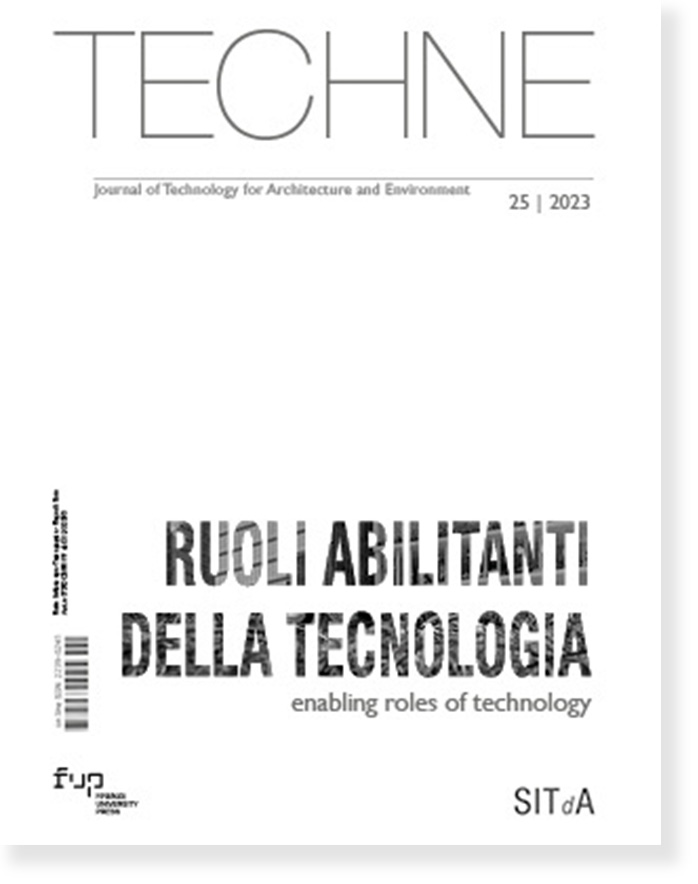Published 2023-05-30
Keywords
- Building renovation,
- Well-being,
- Monitoring System,
- Digital Twin,
- User-experience
- Service Design ...More
How to Cite
Copyright (c) 2023 Antonella Trombadore, Debora Giorgi, Gisella Calcagno, Giacomo Pierucci

This work is licensed under a Creative Commons Attribution 4.0 International License.
Abstract
Focus on the role of users is the heart of the ongoing research experience in the university Living Lab environment that investigates, systematises and tests the potential of the latest digital technologies in the construction sector (BIM-sensors-Digital Twin-IoT) to define enabling building-user interfaces that support the virtuous circle of energy efficiency/environmental well-being/proactive behaviour. Synchronising the real building/virtual model allows an augmented environmental experience and new levels of user involvement. It enriches the predictive systems of data-user experience, helping to calibrate the configuration of improvement scenarios in the design/operational phase on well-being objectives, expanding the awareness of the process actors for a new centrality of the decision as an ethical value.
Downloads
References
Collina, L., Di Sabatino, P., Galluzzo, L. and Mastrantoni, C. (2018), Spatial and Service Design: Guidelines Defining University Dormitories, in Aaron Marcus and Wentao Wang (Eds.) Design, User Experience, and Usability: Theory and Practice. 7th International Conference, DUXU 2018 Held as Part of HCI International 2018 Las Vegas, NV, USA, July 15–20, 2018, Proceedings, Part I, pp. 14-26.
Del Nord, R. (2016), Potenzialità dell’area tecnologica in tema di ricerca progettuale, in Perriccioli, M. (ed.) Pensiero Tecnico e cultura del progetto. Riflessioni sulla ricerca tecnologica in architettura, Franco Angeli, Milano, pp. 121-128.
Deng, M., Menassa, C. and Kamat, V. (2021), From BIM to digital twins: a systematic review of the evolution of intelligent building representations in the AEC-FM industry. Journal of Information Technology in Construction, 26, pp.58-83.
Farzaneh, A., Monfet, D. and Forgues, D. (2019), Review of using Building Information Modeling for building energy modeling during the design process. Journal of Building Engineering, 23, pp.127-135.
Fassi, D., Galluzzo, L. and De Rosa, A. (2018), Service+Spatial design: Introducing the fundamentals of a transdisciplinary approach, Conference Proceedings ServDes. 2018. Proof of Concept. Milan Italy 18-20 June 2018. Linköping University Electronic Press, pp. 847-862.
Kalviainen M. (2022), User-driven Service Design for Environmentally Responsible Consumption, Lathi: LAB University of Applied Sciences.
Karrer, F., (2022) Buildings, city and territory between real complexity and decision-making reductivism. TECHNE - Journal of Technology for Architecture and Environment, 23, pp.21-25
Longoria, L., López-Forniés, I., Sáenz, D. and Sierra-Pérez, J. (2021), Promoting sustainable consumption in Higher Education Institutions through integrative co-creative processes involving relevant stakeholders. Sustainable Production and Consumption, 28, pp.445-458
Manzini, E. (2016), Design when everybody designs, MIT Press, Cambridge.
Meroni, A. and Sangiorgi, D. (2011), Design for Services, Routledge, London.
Pelle, E. (2008), Participation in design things. in Proceedings of the Tenth Conference on Participatory Design, PDC 2008, Bloomington, Indiana, USA, October 1-4, 2008.
Rinaldi, S., Bellagente, P., Ciribini, A., Tagliabue, L., Poli, T., Mainini, A., Speroni, A., Blanco Cadena, J. and Lupica Spagnolo, S. (2020), A Cognitive-Driven Building Renovation for Improving Energy Efficiency, The Experience of the ELISIR Project, Electronics, 9(4), 666.
Sangiorgi, D. (2011), Transformative Services and Transformation Design, in International Journal of Design, Vol. 5, n. 2.
Shahzad, M., Shafiq, M., Douglas, D. and Kassem, M. (2022), Digital Twins in Built Environments: An Investigation of the Characteristics, Applications, and Challenges. Buildings, 12(2), 120.
Sierra-Pérez, J., Grenha Teixeira, J., Romero-Piqueras, C. and Patrício, L. (2021), Designing sustainable services with the ECO-Service design method: Bridging user experience with environmental performance, Journal of Cleaner Production, Vol. 305, 127228.
Torricelli, M. C. (2017), Technological culture, theories and practice in architectural design. TECHNE - Journal of Technology for Architecture and Environment, 13, pp. 21-26.
Van Geetsom, N. and Wilkinson A. (2021), Design culture (of) resilience. Space & Service design taxonomy, overcoming undefined space & service design contexts. Cumulus Conference Proceedings Roma 2021, Track: Design Culture (of) RESILIENCE, pp. 3264-3281
Zaballos, A., Briones, A., Massa, A., Centelles, P. and Caballero, V. (2020), A Smart Campus’ Digital Twin for Sustainable Comfort Monitoring. Sustainability, 12(21), 9196.






